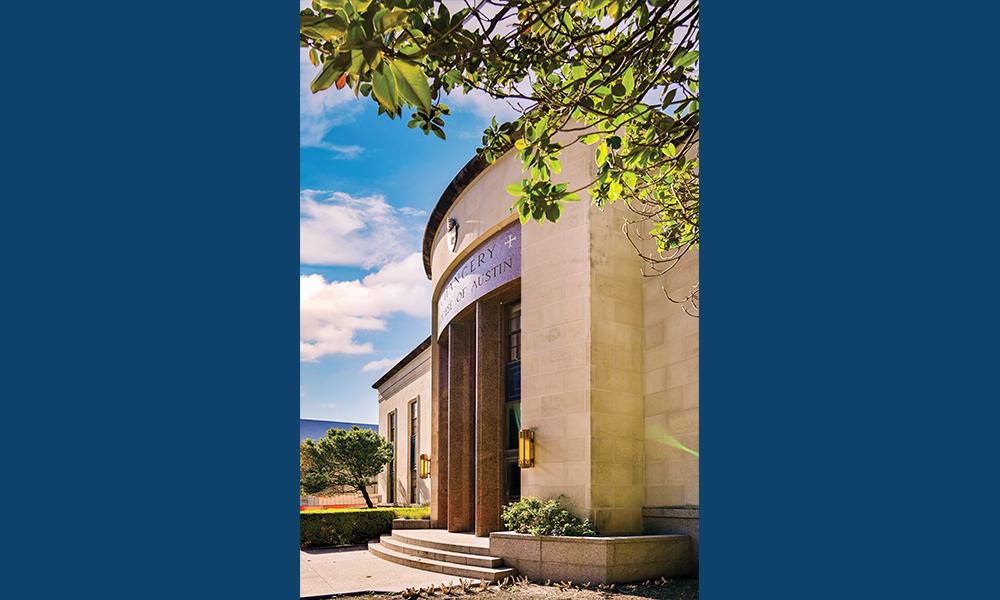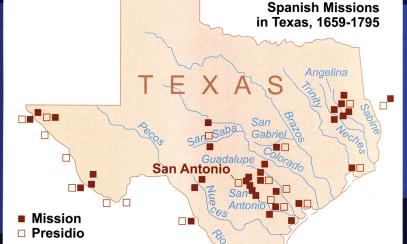
The Chancery has Seen Many Changes Through the Years
¡Lee este artículo en español!
Dedicated in 1958 while Bishop Louis Reicher was bishop of Austin, the historic Leuders Limestone and granite-trimmed Chancery proudly sits at 1600 Congress in Austin. Formerly the site of the Kirby Mansion, which in its later years served as a hotel, the Chancery has served as the seat of the administrative functions of the diocese and also at times has been home to the sitting bishop. The Kirby Mansion property was purchased from Southern Methodist University in 1954 for $45,000. SMU was the beneficiary of a trust that was established by R. Harper Kirby, a distinguished Methodist layman and prohibition leader in the early 1900s.
¡Lee este artículo en español!
Dedicated in 1958 while Bishop Louis Reicher was bishop of Austin, the historic Leuders Limestone and granite-trimmed Chancery proudly sits at 1600 Congress in Austin. Formerly the site of the Kirby Mansion, which in its later years served as a hotel, the Chancery has served as the seat of the administrative functions of the diocese and also at times has been home to the sitting bishop. The Kirby Mansion property was purchased from Southern Methodist University in 1954 for $45,000. SMU was the beneficiary of a trust that was established by R. Harper Kirby, a distinguished Methodist layman and prohibition leader in the early 1900s.
After the demolition of the Kirby Mansion, several years of detailed architectural planning ensued before construction commenced in 1957 with Walter Cooke serving as architect and the J.C. Evans Construction Co. serving as general contractor for the project.
Administration of the Austin Diocese was housed at Newman Hall adjacent to St. Austin Parish from its 1948 inception until the Chancery was completed 10 years later. Originally, the Chancery housed all the diocesan administrative functions, but as the diocese grew, other space was procured in various locations in the Austin area. In 2008 most diocesan offices were consolidated at the Pastoral Center on Highway 290 East in Austin.
The Chancery was remodeled in 2008 to provide living quarters for the bishop on the second floor and gathering places for meetings and receptions on the first floor. From its inception, the beautiful St. Nicholas Chapel, named in honor of Bishop Nicholas Gallagher of the Galveston-Houston Diocese, has graced the southwest corner of the Chancery’s first floor and continues to be used for prayer, worship and occasional Masses at the bishop’s discretion. Replete with beautiful marble flooring and handsome wood-paneled walls throughout most of the first floor, the building also has a large basement that enabled the facility to be designated as a public fallout shelter in years gone by.
A tunnel connects the basement to an outbuilding on the west side of the property that was originally used as a garage for Chancery officials. That building is now the home of the Texas Conference of Catholic Bishops. An imposing bronze statue of St. Peter adorns the well-landscaped front of the Chancery facing Congress Avenue.
In 2020 the Chancery was closed to accommodate the construction of the Capitol Mall project directly to the east of the property. With a significant portion of Phase I of the Capitol Mall complete and after some updating of the property, the Chancery has now reopened with the chapel and gathering places on the first floor and the bishop’s quarters on the second floor. This historic and beautiful marvel, located some 750 feet north of the Texas Capitol, is one of the true architectural treasures of the Diocese of Austin.
Karl Kuykendall is a retired commercial bank executive and a member of St. Mary Parish in Temple. He has lived in the Diocese of Austin for more than 50 years. He is the author of Faith & Perseverance: The History of the Catholic Church in Central Texas, which was recently published by Amazon.



